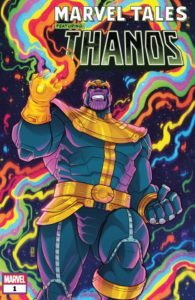 Marvel Tales: Thanos #1 (of 1) — Writer: Jim Starlin; Art: Various
Marvel Tales: Thanos #1 (of 1) — Writer: Jim Starlin; Art: Various
True Believers: Avengers — Thanos and Gamora #1 (of 1) — Writer: Jim Starlin; Pencils: Angel Medina; Inks: Robert Almond; Colors: Ian Laughlin
True Believers: Avengers — Stormbreaker #1 (of 1) — Writer/Artist: Walt Simonson; Colors: George Roussos
True Believers: Avengers — Ronin #1 (of 1) — Writer: Brian Michael Bendis; Pencils: Leinil Francis Yu; Inks: Jim Cheung; Colors: Justin Ponsor
Marvel’s got a quartet of Thanos/Avengers reprints out this week, in continuing 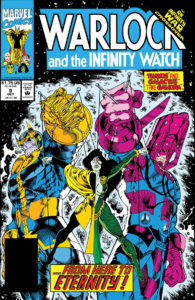 preparation for the big movie conclusion coming in just a few weeks. Marvel Tales: Thanos will set you back $7.99, but reprints three comics written by Jim Starlin, who created both the purple-hued Titan and many of the events and beats that both Avengers: Infinity Gauntlet and Avengers: Endgame are using. The first, from Warlock #10, is right in the middle of Starlin’s first mid-’70s burst of creativity, right after he’d introduced Thanos and made him the cornerstone of a popular Captain Marvel run; here, he’s both writer and artist, and there are enough summaries of previous action, and pointed philosophical dialogue, to establish the Adam Warlock/Thanos adversary relationship that is still the basis for “Infinity” stories, over 40 years later. The second reprint, from Silver Surfer #45, is smack in the middle of the original early-’90s Infinity Gauntlet mini-series; it’s a stand-alone story wherein Thanos has the full Gauntlet, has defeated everyone, and is now
preparation for the big movie conclusion coming in just a few weeks. Marvel Tales: Thanos will set you back $7.99, but reprints three comics written by Jim Starlin, who created both the purple-hued Titan and many of the events and beats that both Avengers: Infinity Gauntlet and Avengers: Endgame are using. The first, from Warlock #10, is right in the middle of Starlin’s first mid-’70s burst of creativity, right after he’d introduced Thanos and made him the cornerstone of a popular Captain Marvel run; here, he’s both writer and artist, and there are enough summaries of previous action, and pointed philosophical dialogue, to establish the Adam Warlock/Thanos adversary relationship that is still the basis for “Infinity” stories, over 40 years later. The second reprint, from Silver Surfer #45, is smack in the middle of the original early-’90s Infinity Gauntlet mini-series; it’s a stand-alone story wherein Thanos has the full Gauntlet, has defeated everyone, and is now 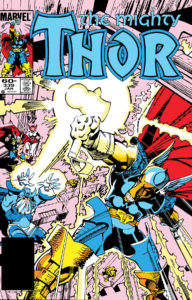 contemplating what comes next — with the wily Mephisto showing up to serve as instructor, toady and possible usurper. Ron Lim, who partnered with Starlin on much of his Surfer run, and part of Infinity Gauntlet itself, handles the art. The final reprint is from Warlock and the Infinity Watch, a few years later, during the Infinity War sequel to the original Gauntlet; it’s also written by Starlin, with art by Tom Raney and Keith Williams, and focuses on the Thanos/Gamora relationship. All three tales show Starlin’s talent at integrating character, cosmic philosophizing, action and even humor, and help explain why Marvel comics with his original cast and ideas — and, often, the word “Infinity” in the title — are still popular today. If that last Warlock and the Infinity Watch reprint intrigues you, you can get its next issue — also written by Starlin, and including the origin
contemplating what comes next — with the wily Mephisto showing up to serve as instructor, toady and possible usurper. Ron Lim, who partnered with Starlin on much of his Surfer run, and part of Infinity Gauntlet itself, handles the art. The final reprint is from Warlock and the Infinity Watch, a few years later, during the Infinity War sequel to the original Gauntlet; it’s also written by Starlin, with art by Tom Raney and Keith Williams, and focuses on the Thanos/Gamora relationship. All three tales show Starlin’s talent at integrating character, cosmic philosophizing, action and even humor, and help explain why Marvel comics with his original cast and ideas — and, often, the word “Infinity” in the title — are still popular today. If that last Warlock and the Infinity Watch reprint intrigues you, you can get its next issue — also written by Starlin, and including the origin 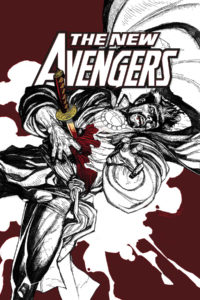 of Gamora — as one of three $1 “True Believers” reprints also out this week; the other two don’t have any Thanos, but do spotlight Thor (in a reprint of the third Walt Simonson written/drawn Mighty Thor #339, from the early ’80s, featuring Beta Ray Bill), and the Avengers themselves (from 2005’s New Avengers #30, part of the long Brian Bendis/Leinil Francis Yu run on that title, in the aftermath to the first Civil War and just before the run-up to the subsequent Skrull-focused Secret Invasion). All three together will set you back less than one new comic, and, if their taste of the creative teams and time periods they’re reproducing gets you to explore those stories further, then they’ve done their job well.
of Gamora — as one of three $1 “True Believers” reprints also out this week; the other two don’t have any Thanos, but do spotlight Thor (in a reprint of the third Walt Simonson written/drawn Mighty Thor #339, from the early ’80s, featuring Beta Ray Bill), and the Avengers themselves (from 2005’s New Avengers #30, part of the long Brian Bendis/Leinil Francis Yu run on that title, in the aftermath to the first Civil War and just before the run-up to the subsequent Skrull-focused Secret Invasion). All three together will set you back less than one new comic, and, if their taste of the creative teams and time periods they’re reproducing gets you to explore those stories further, then they’ve done their job well.
 Avengers: No Road Home #9 (of 10)(Legacy #716) — Writers: Jim Zub, Mark Waid and Al Ewing; Art: Paco Medina; Colors: Jesus Aburtov
Avengers: No Road Home #9 (of 10)(Legacy #716) — Writers: Jim Zub, Mark Waid and Al Ewing; Art: Paco Medina; Colors: Jesus Aburtov
Savage Sword of Conan #4 — Writer: Gerry Duggan; Art: Ron Garney; Colors: Richard Isanove
Age of Conan: Belit #2 (of 5) — Writer: Tini Howard; Art: Kate Niemczyk; Colors: Jason Keith
War of the Realms: Journey Into Mystery #1 (of 5) — Writers: The McElroys; Art: Andre Lima Aravjo; Colors: Chris O’Halloran
 Asgardians of the Galaxy #8 — Writer: Cullen Bunn; Art: Matteo Lolli; Colors: Federico Blee
Asgardians of the Galaxy #8 — Writer: Cullen Bunn; Art: Matteo Lolli; Colors: Federico Blee
Unbeatable Squirrel Girl #43 — Writer: Ryan North; Art: Derek Charm; Colors: Rico Renzi
Avengers: No Road Home reaches its penultimate issue, so it’s now at the stage where you’re either reading it or not, and my opinion isn’t going to sway you (well, until the trade collection…); that said, it’s been a solid, widescreen adventure, with a cast of Hulk, Hawkeye, Scarlet Witch, Rocket Raccoon, the Vision, Spectrum, Voyager, and, of all characters, Conan the Barbarian, all fighting one of those revenge-fueled remake-the-universe menaces. Conan’s 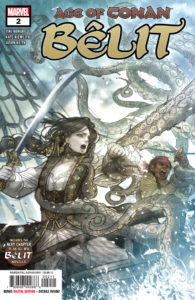 appearance is no accident; since Marvel’s retained his licensing rights again, they’ve launched two comics bearing his name, in addition to a round of “Age of Conan” mini-series. Savage Sword of Conan, like the main Conan book, is concentrating on six-issue arcs; this week’s issue sees Gerry Duggan and Ron Garney in the middle of a typical sword-and-sorcery one, with some nice Garney splash pages and an Alex Ross cover that juxtaposes a portrait of the barbarian against some classic covers from the title’s black-and-white-magazine past. The “Age of Conan” entry Belit, also out this week, offers a female creators’ take on the origin of that pirate queen; Kate Niemczyk’s manga-ish art is as direct and fierce as writer Tini Howard makes its subject, and, as with the previous issue, getting Monstress
appearance is no accident; since Marvel’s retained his licensing rights again, they’ve launched two comics bearing his name, in addition to a round of “Age of Conan” mini-series. Savage Sword of Conan, like the main Conan book, is concentrating on six-issue arcs; this week’s issue sees Gerry Duggan and Ron Garney in the middle of a typical sword-and-sorcery one, with some nice Garney splash pages and an Alex Ross cover that juxtaposes a portrait of the barbarian against some classic covers from the title’s black-and-white-magazine past. The “Age of Conan” entry Belit, also out this week, offers a female creators’ take on the origin of that pirate queen; Kate Niemczyk’s manga-ish art is as direct and fierce as writer Tini Howard makes its subject, and, as with the previous issue, getting Monstress  artist Sana Takeda to draw the covers makes for a very attractive comic. Journey Into Mystery is the first of a bunch of War of the Realms tie-ins; it involves Queen Freja giving a resurrected Balder the Brave a baby (hers and Odin’s) and charging him to protect it while she kills trolls and frost giants and other Earth invaders. Following an oracle’s advice, he ends up with a team consisting of Spider-Man, Hawkeye, Deathlok, Doctor Strange, and others — except that it turns out to be the Miles Morales Spider-Man, the Kate Bishop Hawkeye, and similarly younger or off-brand versions of everybody else, too; this group of misfits has to travel across country while protecting the kid. Fair enough, although the tone wavers between tongue-in-cheek and serious, and after all the set-up it’s
artist Sana Takeda to draw the covers makes for a very attractive comic. Journey Into Mystery is the first of a bunch of War of the Realms tie-ins; it involves Queen Freja giving a resurrected Balder the Brave a baby (hers and Odin’s) and charging him to protect it while she kills trolls and frost giants and other Earth invaders. Following an oracle’s advice, he ends up with a team consisting of Spider-Man, Hawkeye, Deathlok, Doctor Strange, and others — except that it turns out to be the Miles Morales Spider-Man, the Kate Bishop Hawkeye, and similarly younger or off-brand versions of everybody else, too; this group of misfits has to travel across country while protecting the kid. Fair enough, although the tone wavers between tongue-in-cheek and serious, and after all the set-up it’s 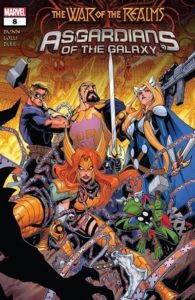 going to take a few issues to determine whether the story works (since Odin “died” in War of the Realms #1, my totally uninformed guess is that he’ll resurrect in the kid, probably in the nick of time to turn the tide in the invasion…). Asgardians of the Galaxy also has a War of the Realms tie-in involving a misfit crew, but, as the title wordplay proclaims, they all have connections to the Norse realm: there’s Thor’s sister Angela, Valkyrie and her human host, Skurge the Executioner, Thunderstrike (the son of that ’90s Thor replacement) and the frog that got an uru enchantment and ended up with superpowers who’s called, of course, “Throg”; their involvement in the festivities flows more smoothly and logically than the Journey Into Mystery‘s group does. The most unexpected crossover, though, has to go to The
going to take a few issues to determine whether the story works (since Odin “died” in War of the Realms #1, my totally uninformed guess is that he’ll resurrect in the kid, probably in the nick of time to turn the tide in the invasion…). Asgardians of the Galaxy also has a War of the Realms tie-in involving a misfit crew, but, as the title wordplay proclaims, they all have connections to the Norse realm: there’s Thor’s sister Angela, Valkyrie and her human host, Skurge the Executioner, Thunderstrike (the son of that ’90s Thor replacement) and the frog that got an uru enchantment and ended up with superpowers who’s called, of course, “Throg”; their involvement in the festivities flows more smoothly and logically than the Journey Into Mystery‘s group does. The most unexpected crossover, though, has to go to The 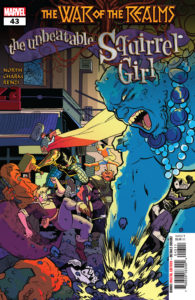 Unbeatable Squirrel Girl, and yet it’s also the best: Doreen approaches a mythological invasion with the same confidence and practicality as everything else, and, after a conversation with Loki (whom she’s encountered frequently and who, like almost everyone else, is charmed by her), she gets zapped to Canada to protect her parents’ town, look for a key enemy headquarters — and encounter an Asgardian-related menace from her comic’s first volume. The story works equally well for hardcore Marvel fans and readers who’ve never read any comic but this one — a neat trick, and a tribute to Ryan North and Derek Charm’s amiable, thoughtful creativity.
Unbeatable Squirrel Girl, and yet it’s also the best: Doreen approaches a mythological invasion with the same confidence and practicality as everything else, and, after a conversation with Loki (whom she’s encountered frequently and who, like almost everyone else, is charmed by her), she gets zapped to Canada to protect her parents’ town, look for a key enemy headquarters — and encounter an Asgardian-related menace from her comic’s first volume. The story works equally well for hardcore Marvel fans and readers who’ve never read any comic but this one — a neat trick, and a tribute to Ryan North and Derek Charm’s amiable, thoughtful creativity.
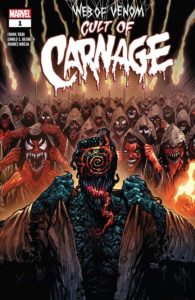 Web of Venom: Cult of Carnage #1 (of 1) — Writer: Frank Tieri; Art: Danilo S. Beyruth; Colors: Andres Mossa
Web of Venom: Cult of Carnage #1 (of 1) — Writer: Frank Tieri; Art: Danilo S. Beyruth; Colors: Andres Mossa
Symbiote Spider-Man #1 — Writer: Peter David; Pencils: Greg Land; Inks: Jay Leisten; Colors: Frank D’Armata
Amazing Spider-Man #19 (Legacy #820) — Writer: Nick Spencer; Art: Gerardo Sandoval; Colors: Edgar Delgado and Erick Arciniega
Unstoppable Wasp #6 — Writer: Jeremy Whitley; Art: Alti Firmansyan; Colors: Espen Grundetjern
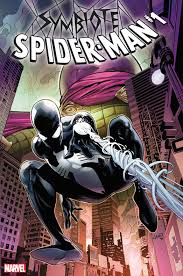 Captain Marvel #4 (Legacy #138) — Writer: Kelly Thompson; Art: Carmen Carnero; Colors: Tamra Bonvillain
Captain Marvel #4 (Legacy #138) — Writer: Kelly Thompson; Art: Carmen Carnero; Colors: Tamra Bonvillain
Web of Venom: Cult of Carnage continues the slow-rolling set-up to an upcoming symbiote event, Absolute Carnage, involving that title serial killer/alien parasite-wearing psycho discovering that he can resurrect Knull, the symbiote god, by ripping out the spines of anyone who’s ever been possessed by a symbiote and absorbing the traces left there; as you can imagine, that’s a huge number of people — including almost every costumed hero, at one time or another — and this book 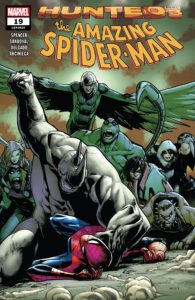 shows him beginning to do just that. Symbiote Spider-Man features in-continuity stories of Spider-Man wearing the symbiote before he knew it was anything but some weird alien polyester; the great news is that its writer is Peter David, who has been around forever (including writing Spidey comics back then), and can tell a skillful and involving story easily and well; artist Greg Land has both strengths and weaknesses, but drawing beautiful women is his forte, and David proves a smart collaborator by having this first issue guest-star our hero’s then-girlfriend, the Black Cat, for Land to lavish his pencils on. Amazing Spider-Man is on the third of a six-part story involving Kraven the Hunter and Arcade trapping the webhead and a bunch of his
shows him beginning to do just that. Symbiote Spider-Man features in-continuity stories of Spider-Man wearing the symbiote before he knew it was anything but some weird alien polyester; the great news is that its writer is Peter David, who has been around forever (including writing Spidey comics back then), and can tell a skillful and involving story easily and well; artist Greg Land has both strengths and weaknesses, but drawing beautiful women is his forte, and David proves a smart collaborator by having this first issue guest-star our hero’s then-girlfriend, the Black Cat, for Land to lavish his pencils on. Amazing Spider-Man is on the third of a six-part story involving Kraven the Hunter and Arcade trapping the webhead and a bunch of his 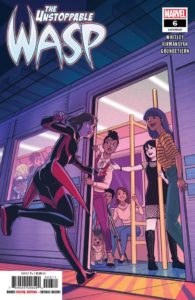 animal-themed villains, and selling the rights to kill them via VR-headset safaris to bored and violent NYC one-percenters; that all took a while to set up, but now it’s in the high-action most-dangerous-game phase, and watching Spidey interact with dozens of villains while their captors shoot at them is basic-but-satisfying superhero fun. Unstoppable Wasp ends its first six-issue arc with Nadia mending fences and dealing with her (realistically, for a superhero book) manic-depressive diagnosis; it also fleshes out the rest of its girl-scientist cast, both with power-ups and with relationship-building (particularly between Ling and Shay); it continues to be a solid edition to the Squirrel Girl/Ms.
animal-themed villains, and selling the rights to kill them via VR-headset safaris to bored and violent NYC one-percenters; that all took a while to set up, but now it’s in the high-action most-dangerous-game phase, and watching Spidey interact with dozens of villains while their captors shoot at them is basic-but-satisfying superhero fun. Unstoppable Wasp ends its first six-issue arc with Nadia mending fences and dealing with her (realistically, for a superhero book) manic-depressive diagnosis; it also fleshes out the rest of its girl-scientist cast, both with power-ups and with relationship-building (particularly between Ling and Shay); it continues to be a solid edition to the Squirrel Girl/Ms. 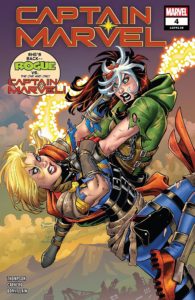 Marvel/Hawkeye/Captain Marvel YA female-empowerment wing of the Marvel universe — a place where some of the best stories are currently being told. Captain Marvel, in fact, is currently written by Kelly Thompson, one of the best practitioners of that style; the new issue, part four of another six-parter involving the Nuclear Man (whose original name as a ’70s FF villain, Mahkizmo, must have been deemed too on the nose) gives Carol plenty of forces to marshal and butts to kick (including the cover-featured run-in with old adversary Rogue), and ought to be both accessible and attractive to some of those fans who’ve driven the CM movie over the billion-dollar worldwide mark by now.
Marvel/Hawkeye/Captain Marvel YA female-empowerment wing of the Marvel universe — a place where some of the best stories are currently being told. Captain Marvel, in fact, is currently written by Kelly Thompson, one of the best practitioners of that style; the new issue, part four of another six-parter involving the Nuclear Man (whose original name as a ’70s FF villain, Mahkizmo, must have been deemed too on the nose) gives Carol plenty of forces to marshal and butts to kick (including the cover-featured run-in with old adversary Rogue), and ought to be both accessible and attractive to some of those fans who’ve driven the CM movie over the billion-dollar worldwide mark by now.
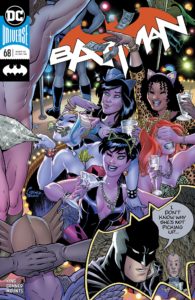 Batman #68 — Writer: Tom King; Art: Amanda Connor, Dan Panosian, John Timms and Mikal Janin; Colors: Paul Mounts, John Timms and Jordie Bellaire
Batman #68 — Writer: Tom King; Art: Amanda Connor, Dan Panosian, John Timms and Mikal Janin; Colors: Paul Mounts, John Timms and Jordie Bellaire
The Batman Who Laughs #4 (of 6) — Writer: Scott Snyder; Art: Jock; Colors: David Baron
Catwoman #10 — Writer: Joelle Jones; Art: Fernando Blanco; Colors: John Kalisz
Superman #10 — Writer: Brian Michael Bendis; Pencils: Ivan Reis and Brandon Peterson; Inks: Oclair Albert and 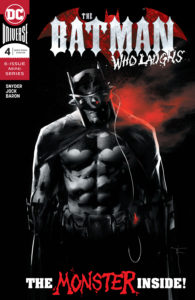 Joe Prado; Colors: Alex Sinclair
Joe Prado; Colors: Alex Sinclair
Wonder Twins #3 (of 6) — Writer: Mark Russell; Art/Colors: Stephen Byrne
Flash #68 — Writer: Joshua Williamson; Art: Scott Kolins; Colors: Luis Guerrero
Batman has the last issue of “Knightmares,” about a captured and unconscious Bruce Wayne dreaming — and it’s saved the best for last, as this follows Lois Lane and Catwoman having a two-woman bachelorette party at the 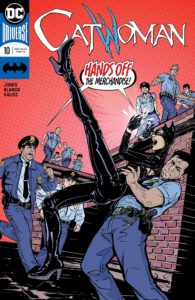 Fortress of Solitude (which turns out to have a huge wine cellar — Superman doesn’t drink, but lots of grateful people and alien races send him wine, and it has to go somewhere — Superman robots, a “bliss pool,” and other party enablers) — and it’s drawn by the amazing Amanda Connor; there are also scenes of Bruce and Clark Kent at Wayne Manor, having their own two-person party by, um, eating soup and playing chess (Batman not being much of a partier…). If you liked that Bat/Cat/Lois/Super double-date issue from a year or two ago, you’ll love this; writer Tom King makes the growing friendship between Lois and Selina poignant, relatable and a lot of fun. “Fun” isn’t an ingredient in this week’s other bat-book, The Batman Who Laughs; it’s Scott Snyder and
Fortress of Solitude (which turns out to have a huge wine cellar — Superman doesn’t drink, but lots of grateful people and alien races send him wine, and it has to go somewhere — Superman robots, a “bliss pool,” and other party enablers) — and it’s drawn by the amazing Amanda Connor; there are also scenes of Bruce and Clark Kent at Wayne Manor, having their own two-person party by, um, eating soup and playing chess (Batman not being much of a partier…). If you liked that Bat/Cat/Lois/Super double-date issue from a year or two ago, you’ll love this; writer Tom King makes the growing friendship between Lois and Selina poignant, relatable and a lot of fun. “Fun” isn’t an ingredient in this week’s other bat-book, The Batman Who Laughs; it’s Scott Snyder and 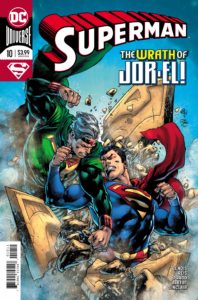 Jock in full grim-and-gritty mode, with our hero battling a Joker-toxin infection while trying to use it to defeat his similarly (and permanently) mutated alternate-universe doppleganger; the two books together show just how flexible the Caped Crusader can be as a story device, and how good comics can come out of both styles — given the right creative teams. Catwoman’s own title begins a new arc with a new caper and a new supporting-cast character; Joelle Jones has gotten a good handle on her heroine after nine previous issues, and it helps that she and artist Fernando Blanco are on the same page (literally…); Blanco’s art even resembles hers, in its stylishness and fashion sense — and is probably better in the action scenes, especially involving a motorcycle-riding, costumed Selina. Superman,
Jock in full grim-and-gritty mode, with our hero battling a Joker-toxin infection while trying to use it to defeat his similarly (and permanently) mutated alternate-universe doppleganger; the two books together show just how flexible the Caped Crusader can be as a story device, and how good comics can come out of both styles — given the right creative teams. Catwoman’s own title begins a new arc with a new caper and a new supporting-cast character; Joelle Jones has gotten a good handle on her heroine after nine previous issues, and it helps that she and artist Fernando Blanco are on the same page (literally…); Blanco’s art even resembles hers, in its stylishness and fashion sense — and is probably better in the action scenes, especially involving a motorcycle-riding, costumed Selina. Superman,  also on its tenth issue after its Brian Bendis-fueled relaunch, finishes Jon’s explanation of what happened to him in space (and why he’s now 17 instead of 10 years old), and sets up a father/son space-battle team-up for next issue; there’s the usual clear, detailed and good-looking Ivan Reis/Brandon Peterson art, and the usual effective Bendis dialogue and characterization (he’s a father of teenagers himself, and his scenes with Lois, Clark and Jon have the rhythms and vocabulary of actual parent/kid conversations — except for the supervillains and ultrahuman abilities, of course…). Wonder Twins has been getting a lot of good reviews; being part of the younger-reader “Wonder Comics” imprint forces author Mark Russell, who’s a natural satirist, to dial back the snark and ramp up the sincerity; the result is a story that still
also on its tenth issue after its Brian Bendis-fueled relaunch, finishes Jon’s explanation of what happened to him in space (and why he’s now 17 instead of 10 years old), and sets up a father/son space-battle team-up for next issue; there’s the usual clear, detailed and good-looking Ivan Reis/Brandon Peterson art, and the usual effective Bendis dialogue and characterization (he’s a father of teenagers himself, and his scenes with Lois, Clark and Jon have the rhythms and vocabulary of actual parent/kid conversations — except for the supervillains and ultrahuman abilities, of course…). Wonder Twins has been getting a lot of good reviews; being part of the younger-reader “Wonder Comics” imprint forces author Mark Russell, who’s a natural satirist, to dial back the snark and ramp up the sincerity; the result is a story that still 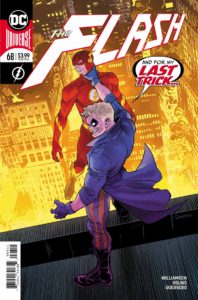 satirizes super-villains (and corporate corruption, via Lex Luthor), but also has a legitimate Super Friends-ish theme (“Kindness is how you save the world”) that arises naturally out of the story, just the way it’s supposed to. Finally, The Flash is in the middle of a three-issue tale reintroducing the original Trickster; Joshua Williamson gives Scott Kolins plenty of opportunity to draw the hyper-fast action he’s so good at, and sets up a last-page cliffhanger that, literally, leaves Barry Allen without a leg to stand on, and is guaranteed to bring everyone back to see how he gets out of it next issue: serialized superhero comics just the way they’re supposed to be.
satirizes super-villains (and corporate corruption, via Lex Luthor), but also has a legitimate Super Friends-ish theme (“Kindness is how you save the world”) that arises naturally out of the story, just the way it’s supposed to. Finally, The Flash is in the middle of a three-issue tale reintroducing the original Trickster; Joshua Williamson gives Scott Kolins plenty of opportunity to draw the hyper-fast action he’s so good at, and sets up a last-page cliffhanger that, literally, leaves Barry Allen without a leg to stand on, and is guaranteed to bring everyone back to see how he gets out of it next issue: serialized superhero comics just the way they’re supposed to be.
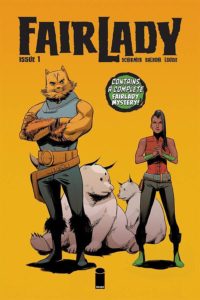 Fairlady #1 — Writer: Brian Schirmer; Art: Claudia Balboni; Colors: Marissa Louise
Fairlady #1 — Writer: Brian Schirmer; Art: Claudia Balboni; Colors: Marissa Louise
Faithless #1 (of 5) — Writer: Brian Azzarello; Art/Colors: Maria Llovet
She Could Fly: The Lost Pilot #1 (of 5) — Writer: Christopher Cantwell; Art: Martin Morazzo; Colors: Miroslav Mrva
Ronin Island #2 — Writer: Greg Pak; Art: Giannis Milonogiannis; Colors: Irma Knivila
 Fairlady is a mashup of the hard-boiled detective and fantasy/Lord of the Rings genres, with its title character the only woman PI in a post-war world where magic and supernatural races exist; it gets a lot of points for offering a stand-alone story in this first issue, so readers can get a full sampling of its charms — which should be more than enough, in both story and art, to bring them back for more. So too for Faithless, a new R-rated horror mini-series by Brian Azzarello — although the horror part doesn’t become clear until the very end. Paul Pope does the cover, and interior artist/colorist Maria Llovet has a similar erotic/attractive style, so it looks great, and does an effective job of introducing its main character
Fairlady is a mashup of the hard-boiled detective and fantasy/Lord of the Rings genres, with its title character the only woman PI in a post-war world where magic and supernatural races exist; it gets a lot of points for offering a stand-alone story in this first issue, so readers can get a full sampling of its charms — which should be more than enough, in both story and art, to bring them back for more. So too for Faithless, a new R-rated horror mini-series by Brian Azzarello — although the horror part doesn’t become clear until the very end. Paul Pope does the cover, and interior artist/colorist Maria Llovet has a similar erotic/attractive style, so it looks great, and does an effective job of introducing its main character 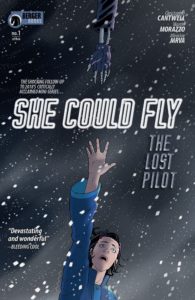 and her new acquaintance to readers; the memorably-chilling image at the very end should make this another comic whose readers will show up eagerly for the next issue. She Could Fly: The Lost Pilot is a sequel to last year’s mini-series about a young woman with OCD and other mental issues who gets involved with the inventor of a personal flying harness and enmeshed in a governmental conspiracy. If you liked the previous series, get this; if you didn’t read it, there’s a front-page story summary that should tell you most of what you need to know. Its author, Christopher Cantwell (the actor and creator of the TV show Stand and Catch Fire, not the “Crying Nazi” guy), has some of the same mental issues as his heroine, so her battles with her condition have the ring
and her new acquaintance to readers; the memorably-chilling image at the very end should make this another comic whose readers will show up eagerly for the next issue. She Could Fly: The Lost Pilot is a sequel to last year’s mini-series about a young woman with OCD and other mental issues who gets involved with the inventor of a personal flying harness and enmeshed in a governmental conspiracy. If you liked the previous series, get this; if you didn’t read it, there’s a front-page story summary that should tell you most of what you need to know. Its author, Christopher Cantwell (the actor and creator of the TV show Stand and Catch Fire, not the “Crying Nazi” guy), has some of the same mental issues as his heroine, so her battles with her condition have the ring  of truth, and help it to stand out. Ronin Island is about a small Asian island where refugees from Korea, Japan, etc. have built a life after some sort of fictional 19th-century disaster that wipes out most of humanity; its main characters, two young friends, are threatened by an invasion from, first, a representative of a new strongman in Japan, and, second, by a mutated horde of monsters. Typically-solid storytelling from Greg (Planet Hulk; Totally Awesome Hulk) Pak and polished manga-esque art from Giannis Milonogiannis (the artist on the Brandon Graham-written Prophet from a couple years ago) make it stand out, too: not that easy a task on today’s crowded comic-book newsstands.
of truth, and help it to stand out. Ronin Island is about a small Asian island where refugees from Korea, Japan, etc. have built a life after some sort of fictional 19th-century disaster that wipes out most of humanity; its main characters, two young friends, are threatened by an invasion from, first, a representative of a new strongman in Japan, and, second, by a mutated horde of monsters. Typically-solid storytelling from Greg (Planet Hulk; Totally Awesome Hulk) Pak and polished manga-esque art from Giannis Milonogiannis (the artist on the Brandon Graham-written Prophet from a couple years ago) make it stand out, too: not that easy a task on today’s crowded comic-book newsstands.



